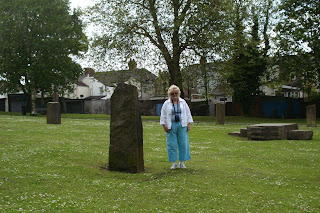CAERPHILLY CASTLE, WALES
May 29. CAERPHILLY, Wales.
This is the town where my father was born. When he lived here it was a small mining village but in the years since I first started visiting Caerphilly, it has grown extensively and is now almost a 'bedroom community' of the big city, Cardiff.
We arrive late last night (May 28) after a long day touring Bath and Old Sarum, then back to London to pick up our luggage at the Indian Y. Fortunately my cousins came and picked us up at Cardiff train station as there were no available hotels due to the Eisteddfod and no more buses running to Caerphilly.
The next morning, we wanted to show Debra around town. I've been here many times and my sister was here once before. Of course, the big feature in Caerphilly is the Norman castle, "Castell Caerphffili" Wale's largest moated medieval castle where you can see working replicas of seige engines. The fortress spreads over 30 acres and is the largest in Britain and one of the best preserved. It was built in the late 13th century by the Anglo-Norman lord, Gilbert de Clare, in order to consolidat his grip on the lands he had captured. The castle's outstanding water defences were more than a mere moat, but created around lakes forming three artificial islands. Notable features inside the castle include the gatehouses, banquet hall and full sized replicas of seige engines. The banquet hall is still used for functions.
I call this "my castle" because for as long as I have memory, from my earliest childhood, I grew up hearing stories about this castle. My father played in there when he was a child and when he left Wales to find a new home in Canada, his friends presented him with a framed photograph of the castle (which I still have) that always hung the walls of our homes.
This is the town where my father was born. When he lived here it was a small mining village but in the years since I first started visiting Caerphilly, it has grown extensively and is now almost a 'bedroom community' of the big city, Cardiff.
We arrive late last night (May 28) after a long day touring Bath and Old Sarum, then back to London to pick up our luggage at the Indian Y. Fortunately my cousins came and picked us up at Cardiff train station as there were no available hotels due to the Eisteddfod and no more buses running to Caerphilly.
The next morning, we wanted to show Debra around town. I've been here many times and my sister was here once before. Of course, the big feature in Caerphilly is the Norman castle, "Castell Caerphffili" Wale's largest moated medieval castle where you can see working replicas of seige engines. The fortress spreads over 30 acres and is the largest in Britain and one of the best preserved. It was built in the late 13th century by the Anglo-Norman lord, Gilbert de Clare, in order to consolidat his grip on the lands he had captured. The castle's outstanding water defences were more than a mere moat, but created around lakes forming three artificial islands. Notable features inside the castle include the gatehouses, banquet hall and full sized replicas of seige engines. The banquet hall is still used for functions.
I call this "my castle" because for as long as I have memory, from my earliest childhood, I grew up hearing stories about this castle. My father played in there when he was a child and when he left Wales to find a new home in Canada, his friends presented him with a framed photograph of the castle (which I still have) that always hung the walls of our homes.
THE HAUNTED BATTLEMENTS
There is an intriguing legend associated with the castle: the Green Lady who haunts the ivy-covered battlements. She was once Princess Alice de la Marche, niece of King Henry II and the wife of Earl Gilbert de Clare. She was also the lover of Tew Teg Gruffydd the Fair, the Welsh prince of Brithdir. Disgraced and banished, they say that on moonlit nights her ghost can be seen walking the castle battlements searching for her lost lover.
I was first told this story on a moonlit night as I walked by the castle with one of my cousins. Was she there then, a misty figure hidden in the ivy? I find the story appealing and want to know more. Perhaps it deserves being written down in a novel. Perhaps there's already one written.
I was first told this story on a moonlit night as I walked by the castle with one of my cousins. Was she there then, a misty figure hidden in the ivy? I find the story appealing and want to know more. Perhaps it deserves being written down in a novel. Perhaps there's already one written.
A DRUID'S STONE CIRCLE
Yes, there are still those who practice the Druid's religion and that's why Stonehenge is now blocked off and you can't get into the inner circle as I did on my first visit some years ago. But in Caerphilly there's this small circle overlooking the castle. I think there may still be the occasional ceremony held here. And whenever I am in town I like to go and visit.








2 comments:
ok the website dose not tell the story of the green lady that is what you need.
If you want the whole story look in www.europeupclose.com under Wales and you'll find it there.
Post a Comment